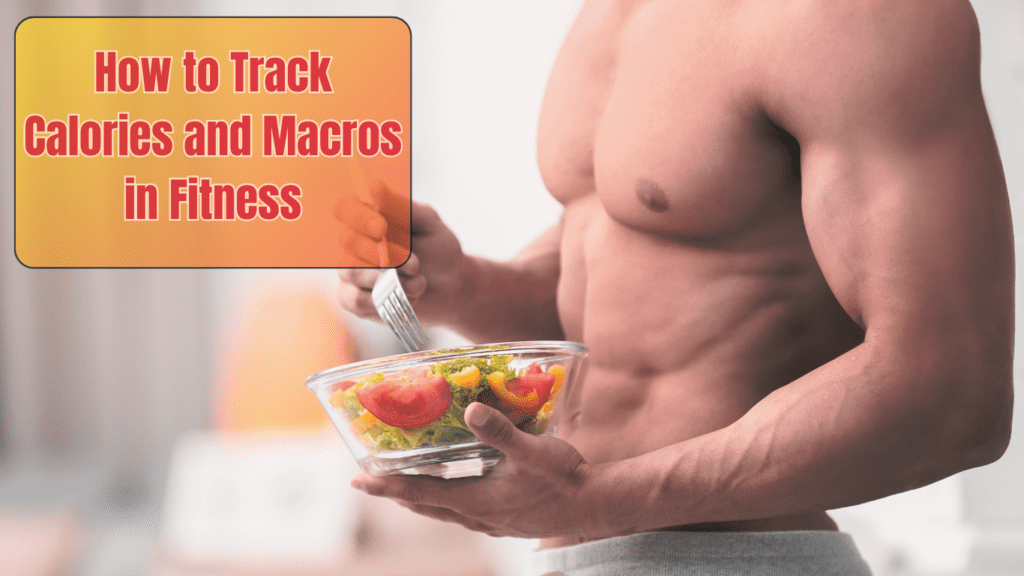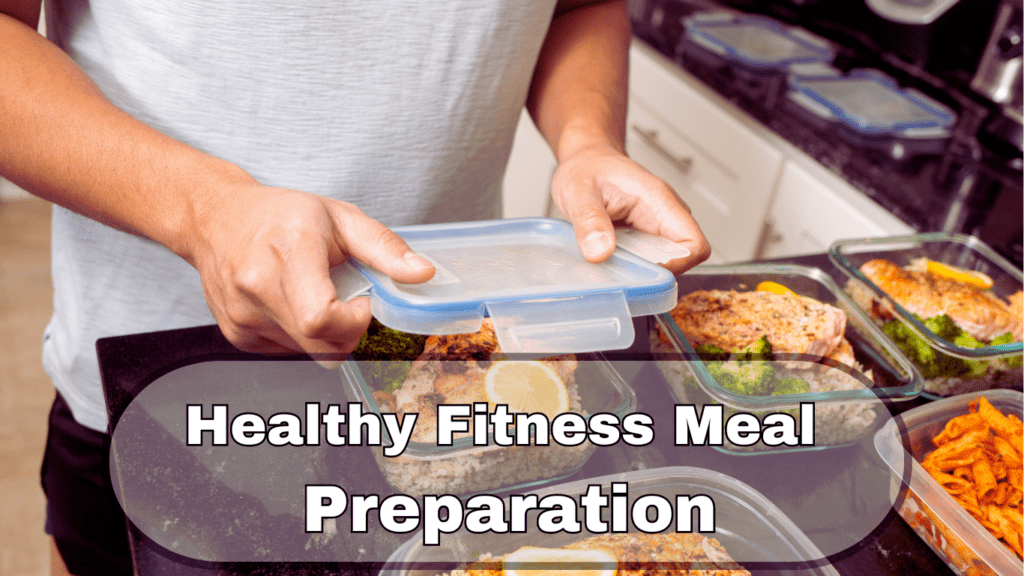What to Eat on Rest Day: Nourishing Your Body for Recovery and Success
In this article, we’ll dive into what to eat on rest day to maximize your recovery, fuel muscle repair, and keep energy steady, giving you practical food ideas and nutrition tips designed to enhance your rest days and support your fitness journey.
Why did the weightlifter bring a loaf of bread to the gym? Because they heard it was the best way to get some “rolls” in their routine! While this joke might bring a smile, it points to an important truth: nutrition on rest days is just as crucial as what you consume on training days. Understanding what to eat on rest day can make a significant difference in your recovery and overall fitness progress. In fact, studies show that the right nutrients can aid in muscle recovery, reduce soreness, and prepare you for your next workout.
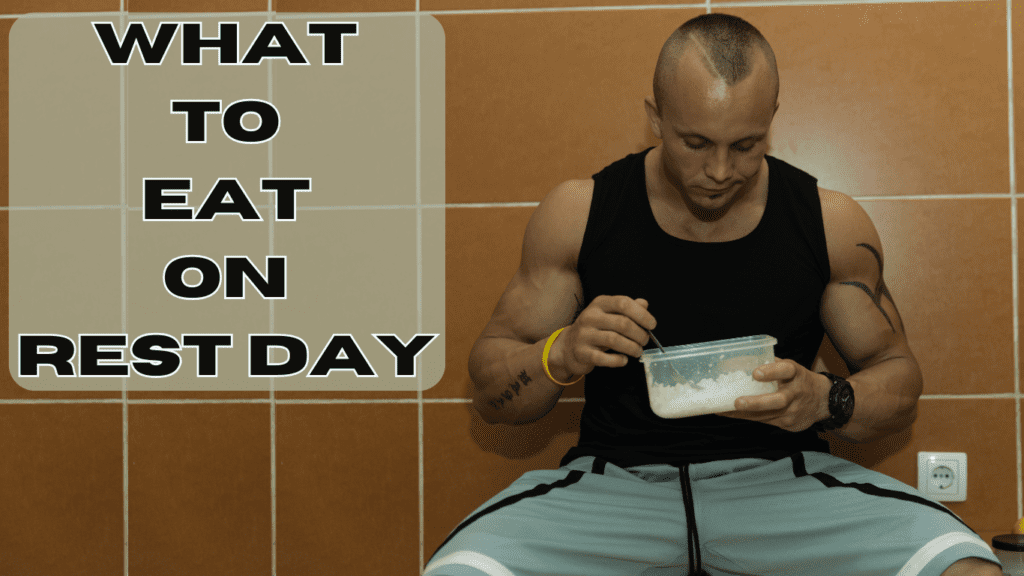
So, why is it important to focus on what to eat on rest day? Your body doesn’t just need rest; it needs the right fuel to recover from the stresses of exercise. Many people mistakenly believe that nutrition is only important on active days, but the reality is that what you eat on your rest day could be just as important as your workout days. Did you know that your muscles need adequate protein and carbohydrates to repair and grow stronger during recovery? If you neglect nutrition on rest days, you might not see the results you desire, no matter how hard you train.
In this article, we will explore various aspects of what to eat on rest day, providing practical advice and insights tailored for individuals at different fitness levels and with varying budgets. Whether you’re a seasoned athlete or just starting out, understanding how to nourish your body during rest days is essential.
You can expect to find information on meal planning, nutritious snack options, and easy-to-follow recipes that align with your fitness goals. We’ll also discuss the key nutrients you should focus on, including protein, carbohydrates, and healthy fats, and how they contribute to effective recovery.
Subscribe And Get Our Free E-Book:Unlocking The Power Of Nutrition-Supplements, Substitutes, and Superfoods!
Why Nutrition Matters on Rest Days
When considering what to eat on rest day, remember that your body is in a state of recovery. This is the time when muscles repair and grow stronger, and your glycogen stores need replenishing. A well-balanced diet that includes the right macronutrients will support these processes. For example, protein is vital for repairing muscle tissue, while carbohydrates provide the necessary energy for your next workout. Including healthy fats in your diet helps with hormone production and overall health, making them an essential component of your nutrition plan.
Overview of What to Expect
In the sections to follow, we’ll delve deeper into specific foods and meal ideas that will help you optimize your rest day nutrition. You’ll learn about:
- Key Nutrients: Discover the importance of protein, carbohydrates, and healthy fats for recovery and performance.
- Meal Planning Tips: Get practical advice on how to plan your meals effectively, even if you have a busy schedule.
- Snack Options: Find out what snacks can keep you satisfied while still supporting your recovery.
- Simple Recipes: We’ll provide easy and delicious recipes that cater to various dietary preferences, ensuring that everyone can find something suitable.
- Budget-Friendly Choices: Learn how to make smart food choices without breaking the bank, so you can prioritize nutrition no matter your financial situation.
As we explore these topics, we aim to provide you with the tools and knowledge you need to make informed decisions about what to eat on rest day. By taking the time to focus on nutrition during your rest days, you’ll set yourself up for greater success in your fitness journey. So, let’s dive into the details and discover how proper nutrition can elevate your performance and enhance your recovery!
How To Diet On Rest Days Video
Understanding Rest Days
What exactly is a rest day? At its core, a rest day is a scheduled break from physical activity that allows your body to recover and rejuvenate. There are generally two types of rest days: complete rest and active recovery.
- Complete Rest: Taking a day off from all physical activities, allowing your muscles and joints to fully recover.
- Active Recovery: Engaging in low-intensity exercises, such as walking, yoga, or light stretching, which can help promote blood flow and aid in recovery without putting too much strain on your body.
Common practices around rest days can vary significantly across different fitness regimens. For instance:
- In CrossFit, athletes may schedule rest days to allow for muscle recovery, as the workouts can be intense and demanding.
- Runners often incorporate rest days to prevent fatigue and maintain peak performance.
- Bodybuilders use them to maximize muscle growth.
Regardless of the approach, understanding the role of rest days is crucial for achieving optimal results in any fitness journey.
Benefits of Rest Days
The benefits of taking rest days are numerous and essential for both physical and mental well-being.
- Muscle Recovery:
- During exercise, especially strength training, tiny tears occur in muscle fibers.
- It is during rest that these muscles rebuild and strengthen.
- Consuming adequate protein, carbohydrates, and healthy fats helps facilitate this recovery process.
- Preventing Burnout:
- Regularly scheduled breaks from intense training can help maintain motivation and mental freshness.
- Continuous training without adequate recovery can lead to physical fatigue and mental burnout.
- By allowing yourself some downtime, you can return to your workouts feeling rejuvenated and ready to tackle new challenges.
- Injury Prevention:
- Continuous training without adequate recovery increases the risk of overuse injuries, such as tendonitis or stress fractures.
- These injuries can sideline you for weeks or even months, halting your progress.
- Incorporating rest days into your routine gives your body the chance to heal and adapt, reducing the likelihood of injury.
So, when considering what to eat on rest day, it’s essential to choose foods that support these benefits. Proper nutrition can enhance muscle recovery, help prevent burnout, and protect against injuries.
- Aim for meals rich in protein, healthy fats, and complex carbohydrates.
- For instance, grilled chicken with quinoa and a side of mixed vegetables is a great option, providing the necessary nutrients for muscle repair and energy replenishment.
- Snacks like Greek yogurt with fruit or a handful of nuts can also contribute to meeting your nutritional needs while keeping your energy levels stable.
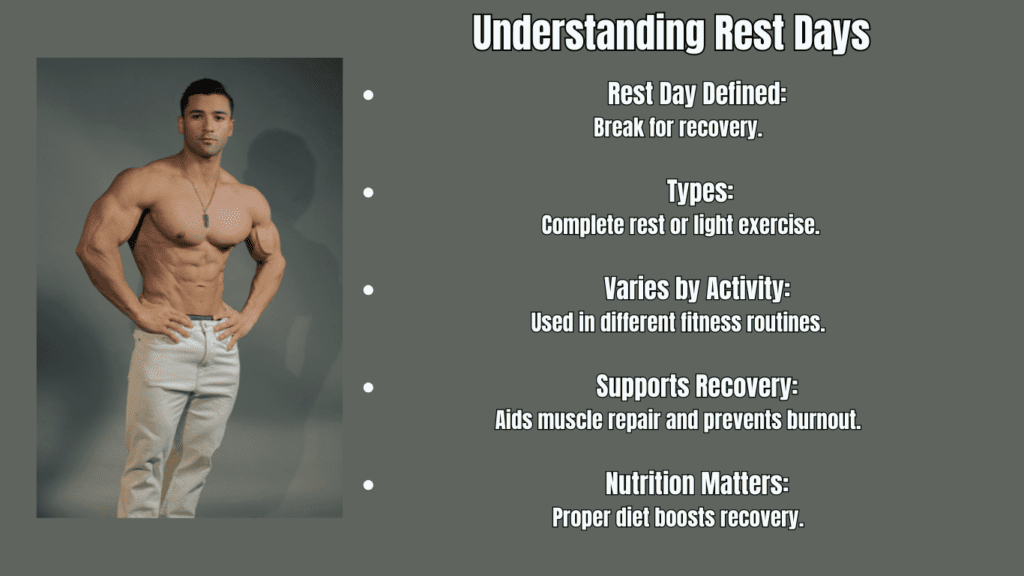
In conclusion, understanding rest days is crucial for anyone pursuing fitness goals. They are not merely a break from exercise but an essential component of a well-rounded fitness regimen. By recognizing the importance of rest and nutrition on these days, you can improve your recovery process and enhance your overall performance.
In the next sections, we will delve into what to eat on rest day, providing practical tips, meal ideas, and recipes tailored to support your recovery and help you achieve your fitness objectives.
The Importance of Nutrition: What to Eat on Rest Day for Optimal Recovery
When it comes to recovery, understanding what to eat on rest day is essential for maintaining your energy levels and supporting overall health. While it’s true that your caloric needs may decrease on these days, this does not mean you should skip meals. In fact, ensuring that you consume balanced meals is crucial for effective recovery and preparing your body for future workouts.
Energy Needs
On rest days, your body requires fewer calories than on workout days, as you are not engaging in intense physical activity. However, this decrease in caloric needs should not lead to neglecting your meals. Skipping meals can result in inadequate nutrient intake, which is vital for recovery. Proper nutrition on rest days helps to replenish energy stores, repair muscle tissue, and prepare your body for the next workout session.
Even on rest days, focus on consuming a well-balanced diet to meet your body’s nutritional requirements. A consistent intake of nutrients is necessary to support recovery processes and maintain overall health.
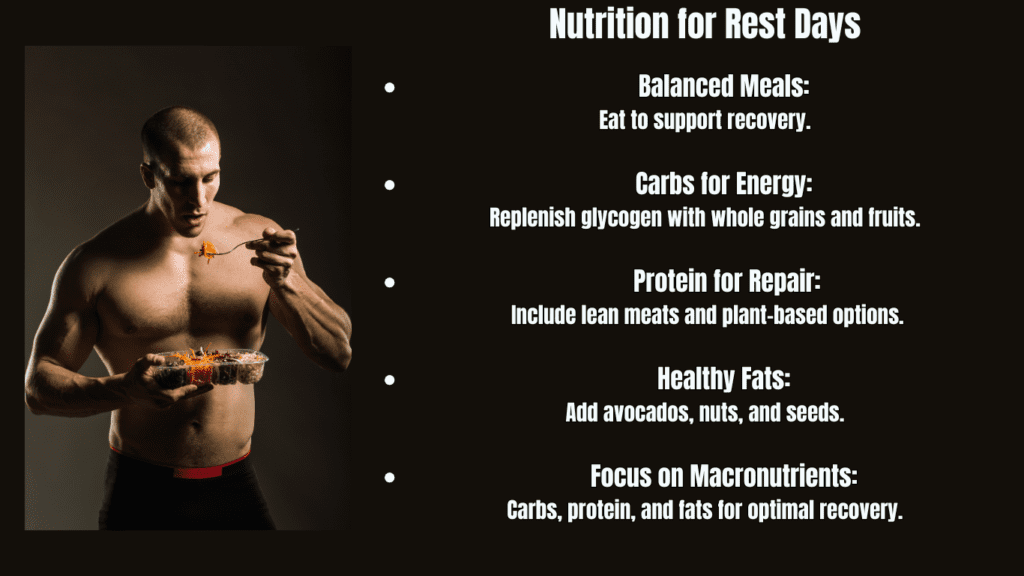
Macronutrients Overview
Understanding the role of macronutrients is key when considering what to eat on rest day. The three main macronutrients—carbohydrates, proteins, and fats—each play a unique and important role in your recovery.
Carbohydrates
Carbohydrates are crucial for replenishing glycogen stores that become depleted during workouts. Even on rest days, consuming the right amount of carbohydrates helps ensure that your energy levels remain stable and that your body is prepared for the next training session.
Healthy sources of carbohydrates include:
- Whole grains: Brown rice, quinoa, and whole grain bread are excellent options that provide sustained energy.
- Fruits: Bananas, berries, and apples are not only delicious but also packed with vitamins and minerals.
- Starchy vegetables: Sweet potatoes and squash are nutrient-dense choices that offer fiber and essential nutrients.
By incorporating these carbohydrate sources into your meals, you will support your body’s energy needs and enhance your recovery process.
Proteins
Proteins play a vital role in muscle repair and growth. After intense workouts, your muscles need protein to recover and become stronger. Consuming adequate protein on rest days will help ensure that your muscles have the nutrients they need to rebuild.
Recommended protein sources include:
- Lean meats: Chicken, turkey, and lean cuts of beef provide high-quality protein.
- Dairy: Greek yogurt and cottage cheese are great sources of protein and also contain calcium for bone health.
- Legumes: Beans, lentils, and chickpeas are excellent plant-based protein options.
- Plant-based proteins: Tofu and tempeh offer protein while being suitable for vegetarians and vegans.
By including these protein-rich foods in your diet, you will support your muscle recovery and growth.
Fats
Healthy fats are often overlooked but are crucial for overall health and well-being. They play a significant role in hormone production, cell function, and reducing inflammation. Including healthy fats in your diet supports recovery and helps maintain energy levels.
Sources of healthy fats include:
- Avocados: Rich in monounsaturated fats and fiber, avocados are a great addition to any meal.
- Nuts: Almonds, walnuts, and pistachios provide healthy fats and protein.
- Seeds: Chia seeds, flaxseeds, and pumpkin seeds are nutrient-dense options that offer healthy fats and omega-3 fatty acids.
- Olive oil: A great source of monounsaturated fats, olive oil can be used in cooking or as a dressing for salads.
Incorporating these sources of healthy fats into your meals can help improve your overall nutrition and support your recovery on rest days.
Chart: Macronutrient Breakdown for Rest Day Recovery
| Macronutrient | Role in Recovery | Benefits for Rest Days | Food Sources |
|---|---|---|---|
| Proteins | Muscle repair & growth | Helps rebuild muscle fibers torn during exercise. Essential for recovery and strength development. | – Chicken, Turkey, Lean Beef – Greek Yogurt, Cottage Cheese – Tofu, Tempeh, Beans, Lentils |
| Carbohydrates | Glycogen replenishment | Replenishes glycogen stores in muscles to maintain energy levels for future workouts. | – Brown Rice, Quinoa, Sweet Potatoes – Bananas, Berries, Apples – Whole Grain Bread, Oats |
| Fats | Hormone production & anti-inflammatory | Supports hormone production, reduces inflammation, and helps absorb vitamins. | – Avocados, Olive Oil – Almonds, Walnuts, Pistachios – Chia Seeds, Flaxseeds |
Understanding what to eat on rest day involves considering your energy needs and focusing on macronutrients. By prioritizing carbohydrates, proteins, and healthy fats, you will support your body’s recovery and prepare it for the next workout. This approach not only enhances your performance but also promotes long-term health and wellness. As we move forward, we will provide practical tips and meal ideas to help you implement these nutritional strategies into your rest day routine effectively.
Nutritional Goals: What to Eat on Rest Day for Recovery and Energy
When planning what to eat on rest day, it’s essential to set clear nutritional goals that support recovery, maintain energy levels, and promote overall health. The strategies you employ on rest days can significantly impact your performance in subsequent workouts and your long-term fitness journey. Let’s explore some key nutritional goals to help you optimize your rest days effectively.
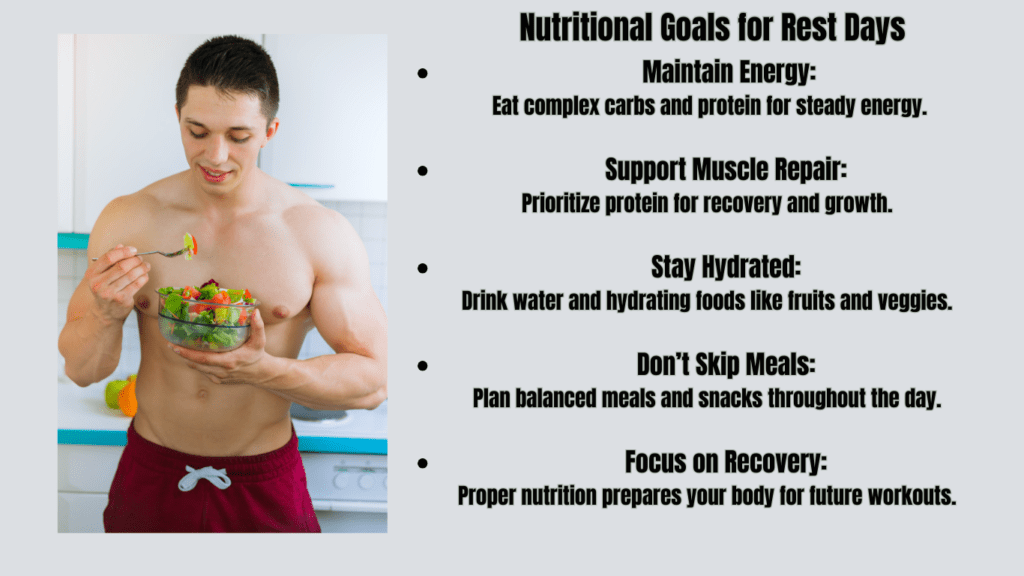
Maintain Energy Levels
One of the primary goals on rest days is to maintain energy levels throughout the day. Even though you might not be engaging in intense workouts, your body still requires sufficient energy to support daily activities and recovery processes.
To achieve balanced meals that provide sustained energy, consider the following strategies:
- Incorporate complex carbohydrates: Foods like whole grains, legumes, and starchy vegetables offer a slow and steady release of energy, preventing blood sugar spikes and crashes.
- Pair protein with carbohydrates: Combining these macronutrients helps enhance satiety and ensures that your body has the necessary building blocks for recovery. For example, try a meal of grilled chicken with quinoa and roasted vegetables.
- Don’t skip meals: Ensure that you consume regular meals and snacks to keep your energy levels stable throughout the day. Plan for three balanced meals and two snacks, focusing on whole foods rich in nutrients.
By implementing these strategies, you’ll be better equipped to maintain energy levels, even on your rest days.
Muscle Repair and Growth
Another crucial nutritional goal when considering what to eat on rest day is supporting muscle repair and growth. Rest days are essential for recovery, and consuming adequate protein is vital to this process.
As a guideline, aim for a target protein intake of 0.6 to 0.8 grams per pound of body weight. This protein intake will help repair the tiny tears in your muscles caused by previous workouts and promote muscle growth.
Recommended protein sources include:
- Lean meats: Chicken, turkey, and fish are excellent sources of high-quality protein.
- Dairy products: Greek yogurt and cottage cheese are not only protein-rich but also provide calcium for bone health.
- Legumes and beans: Lentils, chickpeas, and black beans offer plant-based protein options.
- Plant-based proteins: Tofu, tempeh, and seitan are great alternatives for those following a vegetarian or vegan diet.
By ensuring that you meet your protein needs on rest days, you support muscle recovery and set the stage for improved performance in future workouts.
Hydration
Don’t overlook the importance of hydration on rest days. Staying hydrated is crucial for overall health and plays a significant role in recovery. Dehydration can lead to fatigue, decreased performance, and hindered recovery, so it’s essential to prioritize fluid intake even when you are not actively exercising.
As a guideline, aim to drink at least half your body weight in ounces of water daily. For example, if you weigh 150 pounds, you should aim for about 75 ounces of water per day.
In addition to drinking water, you can include hydrating foods in your diet, such as:
- Cucumbers: These are composed of about 95% water and make for a refreshing snack.
- Oranges: Not only do they provide hydration, but they are also rich in vitamin C, which can help reduce inflammation.
- Watermelon: A delicious, hydrating fruit perfect for satisfying your sweet tooth.
- Strawberries: They are juicy and high in water content, making them an excellent addition to your meals.
By focusing on hydration, you ensure that your body functions optimally and supports your recovery processes.
Rest Day Nutrition Goals: What to Eat for Recovery & Energy
| Goal | Why It Matters | What to Eat |
|---|---|---|
| 1. Keep Energy Steady | Even on rest days, your body needs energy for daily activities and recovery. | – Whole Grains: Brown rice, quinoa, oats – Starchy Vegetables: Sweet potatoes, squash – Fruits: Apples, bananas |
| 2. Repair Muscles | Protein is crucial for repairing muscles after workouts and supporting growth. | – Lean Meats: Chicken, turkey, fish – Dairy: Greek yogurt, cottage cheese – Plant-Based Proteins: Lentils, tofu |
| 3. Stay Hydrated | Hydration helps your body recover and prevents fatigue. | – Water-Rich Foods: Cucumbers, watermelon, oranges, strawberries – Drink Water: Aim for half your body weight in ounces |
| 4. Eat Balanced Meals | A combination of protein, carbs, and healthy fats supports overall recovery. | – Balanced Meals: Grilled chicken + quinoa + roasted veggies, quinoa salad with chickpeas, overnight oats with berries |
| 5. Save Money on Healthy Food | Eating healthy doesn’t have to be expensive. Opt for affordable, nutritious foods. | – Budget Proteins: Eggs, beans, lentils – Affordable Grains: Brown rice, quinoa, oats – Seasonal Veggies: Carrots, broccoli |
How This Chart Helps:
- Goal-Based Nutrition: Each row targets a specific rest day goal like maintaining energy, muscle repair, and hydration.
- Practical Food Ideas: The chart offers easy-to-follow food suggestions that align with each goal, making it simple to plan meals.
- Budget & Variety: For those on a budget or with dietary preferences, the chart includes both affordable options and flexibility in food choices.
When considering what to eat on rest day, it’s essential to set nutritional goals that prioritize energy maintenance, muscle repair, and hydration. By incorporating balanced meals with the right macronutrients and staying adequately hydrated, you can maximize your recovery and prepare your body for future workouts. In the next sections, we will provide practical meal ideas and tips to help you implement these nutritional strategies effectively on your rest days.
What to Eat on Rest Day: Meal Planning and Ingredient Substitutions
When considering what to eat on rest day, it’s essential to make practical food choices that promote recovery and overall well-being. A well-balanced meal plan can help you meet your nutritional goals while still being enjoyable and satisfying. Below, we will outline a sample meal plan, suggest ingredient substitutions for dietary restrictions, and provide budget-friendly options.
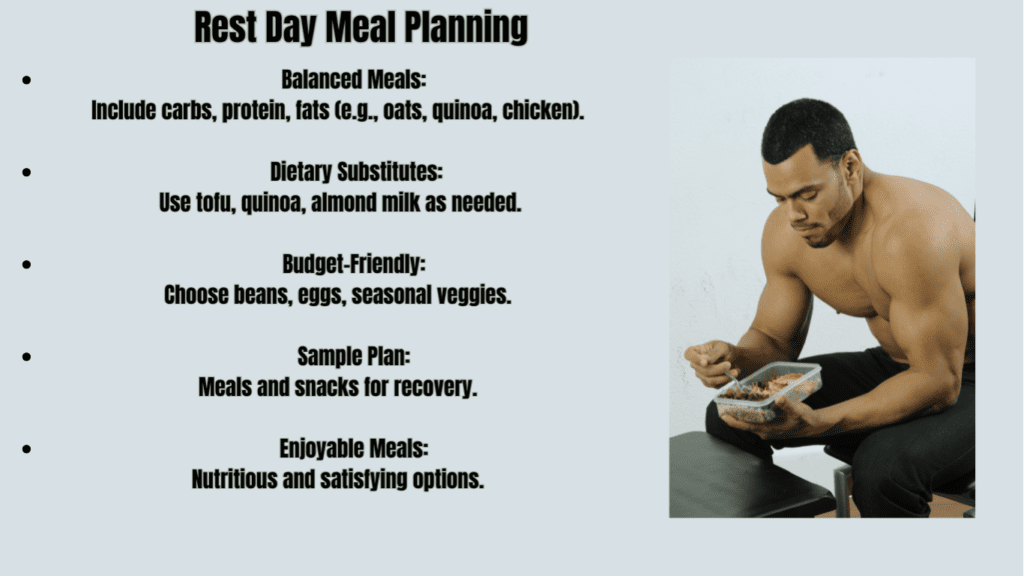
Balanced Meals
A balanced meal should consist of a good mix of carbohydrates, proteins, and healthy fats. Here’s an example meal plan to help guide your choices on what to eat on rest day:
- Breakfast: Start your day with overnight oats topped with Greek yogurt and berries. This meal provides complex carbohydrates, protein, and antioxidants, setting a positive tone for the day.
- Lunch: Enjoy a quinoa salad with chickpeas, mixed vegetables, and vinaigrette. This dish is rich in fiber, protein, and vitamins, making it a nutritious and filling choice.
- Dinner: For dinner, consider having grilled chicken with sweet potatoes and steamed broccoli. This meal delivers lean protein, healthy carbohydrates, and essential vitamins and minerals.
- Snacks: For snacks, pair hummus with carrots or enjoy an apple with almond butter. These options provide healthy fats, fiber, and a satisfying crunch.
This meal plan not only meets your nutritional needs but also keeps your palate happy with diverse flavors and textures.
Ingredient Substitutions
When thinking about what to eat on rest day, it’s crucial to consider dietary restrictions and preferences. Here are some ingredient substitutions to ensure everyone can enjoy their meals:
- For gluten-free diets: Substitute quinoa for grains like wheat or barley. Quinoa is a complete protein and can be used in various dishes.
- Dairy-free options: Use coconut yogurt or almond milk instead of traditional dairy products. These alternatives are widely available and can be used in recipes without sacrificing flavor.
- Plant-based alternatives: For those following a vegan diet, replace grilled chicken with tofu, tempeh, or legumes. These options provide the necessary protein and can be cooked in various ways to suit your taste.
Being mindful of substitutions ensures that everyone can find satisfying options when considering what to eat on rest day.
What to Eat on Rest Day: Budget-Friendly Options
Eating healthy doesn’t have to break the bank. Here are some cost-effective food items that can help you stick to your budget while still making nutritious choices:
- Beans and lentils: These are excellent sources of protein and fiber. They are often cheaper than meat and can be used in various dishes like soups, salads, and stews.
- Eggs: Eggs are a versatile and affordable source of high-quality protein. They can be used in breakfast dishes, salads, or as snacks.
- Seasonal vegetables: Buy vegetables that are in season to save money and enjoy fresh produce. They often taste better and are more affordable.
- Bulk grains: Purchasing grains like brown rice, oats, and quinoa in bulk can significantly reduce costs. These items have a long shelf life and can be used in various meals.
By incorporating these budget-friendly options, you can maintain a nutritious diet while considering what to eat on rest day without overspending.
When deciding what to eat on rest day, focus on balanced meals that include a variety of nutrients. Utilize the example meal plan provided, make necessary ingredient substitutions for dietary needs, and explore budget-friendly options to keep your meals healthy and enjoyable. With these practical food choices, you will not only support your recovery but also enhance your overall health and well-being. As we continue this journey, we will delve deeper into specific recipes and meal prep tips to help you implement these ideas seamlessly into your routine.
Easy-to-Make Recipes
When considering what to eat on rest day, easy-to-make recipes can help you stay on track with your nutrition while also keeping meal preparation simple and stress-free. Preparing quick and nutritious meals not only supports recovery but also fits seamlessly into a busy lifestyle. Below are four simple recipes along with some meal prep tips to make your rest day meals enjoyable and hassle-free.
Recipe 1: Protein-Packed Smoothie
Smoothies are a fantastic way to pack in nutrients without much effort. This Protein-Packed Smoothie is quick to make and perfect for breakfast or as a post-workout snack.
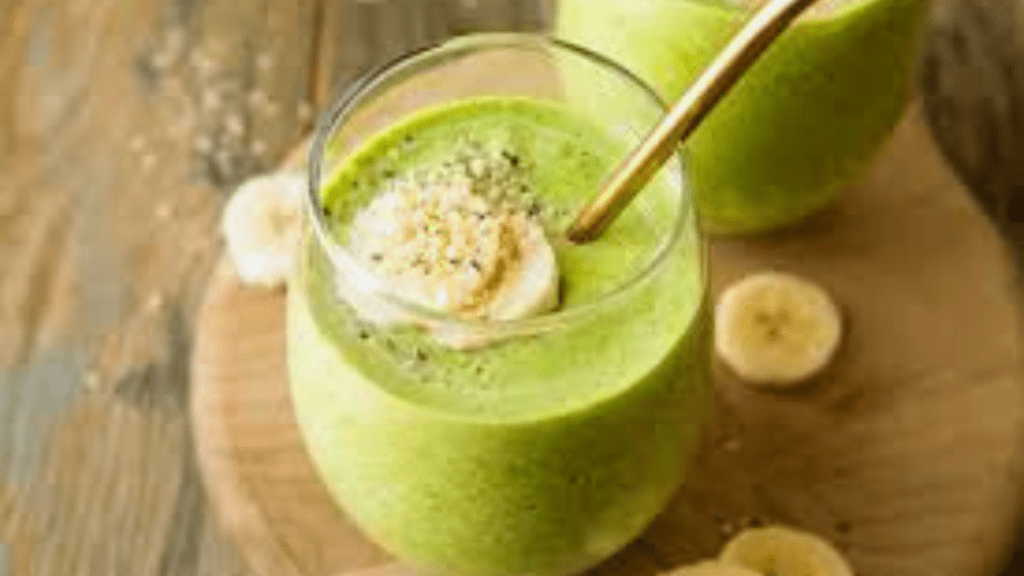
Ingredients:
- 1 banana
- 1 cup spinach
- 1 scoop protein powder (your choice of flavor)
- 1 tablespoon peanut butter
- 1 cup almond milk (or any milk of your choice)
Instructions:
- Combine all ingredients in a blender.
- Blend until smooth, adjusting the almond milk to reach your desired consistency.
- Serve immediately for a refreshing and nutritious drink.
This smoothie is an excellent way to incorporate protein, healthy fats, and greens into your diet, making it a great choice for what to eat on rest day.
Recipe 2: Chickpea Salad
Another easy option is a Chickpea Salad that can be prepared in minutes and enjoyed as a side dish or a light meal.
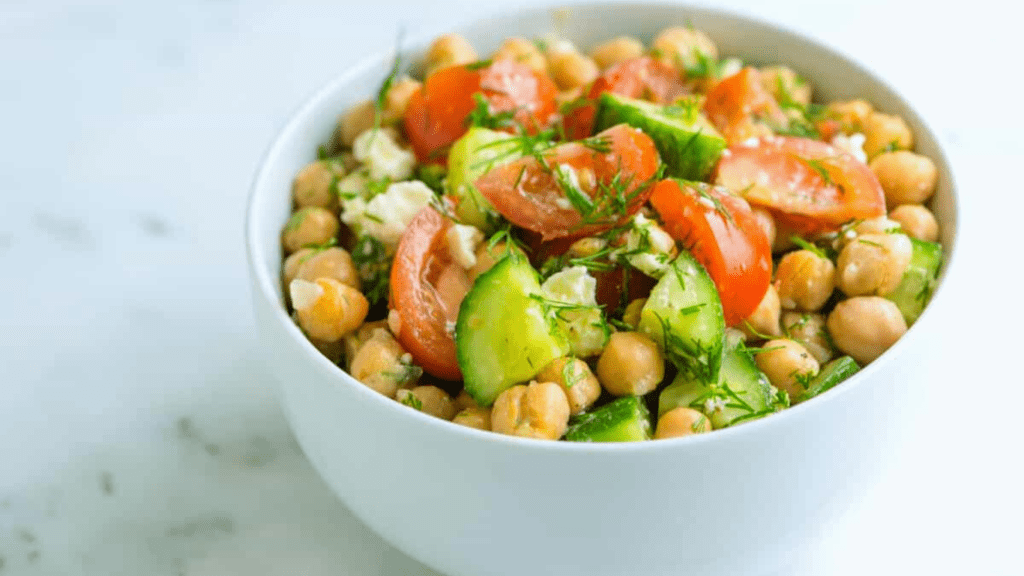
Ingredients:
- 1 can chickpeas (drained and rinsed)
- 1 diced cucumber
- 1 diced tomato
- 1/4 diced onion
- Juice of 1 lemon
- Salt to taste
Instructions:
- Mix all ingredients in a bowl until well combined.
- Serve chilled or at room temperature for a refreshing meal.
This salad is not only nutritious but also rich in fiber and protein, making it an ideal choice when considering what to eat on rest day.
Recipe 3: Quinoa and Black Bean Bowl
A Quinoa and Black Bean Bowl is a wholesome option packed with nutrients and flavor, making it perfect for your rest day.
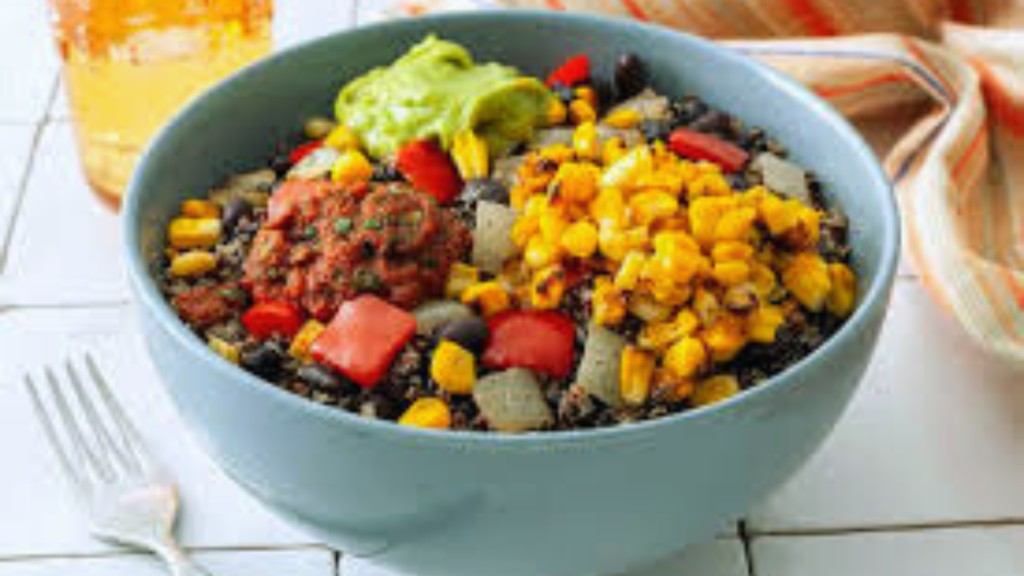
Ingredients:
- 1 cup cooked quinoa
- 1 can black beans (drained and rinsed)
- 1 cup corn (frozen or canned)
- 1 diced bell pepper
- 1 avocado, sliced
- Juice of 1 lime
- Salt and pepper to taste
Instructions:
- In a bowl, combine the quinoa, black beans, corn, and diced bell pepper.
- Drizzle with lime juice and season with salt and pepper.
- Top with sliced avocado before serving.
This bowl is high in protein, fiber, and healthy fats, making it an excellent choice when deciding what to eat on rest day.
Recipe 4: Baked Salmon with Vegetables
This Baked Salmon with Vegetables recipe is not only delicious but also easy to prepare, making it a great addition to your rest day meals.
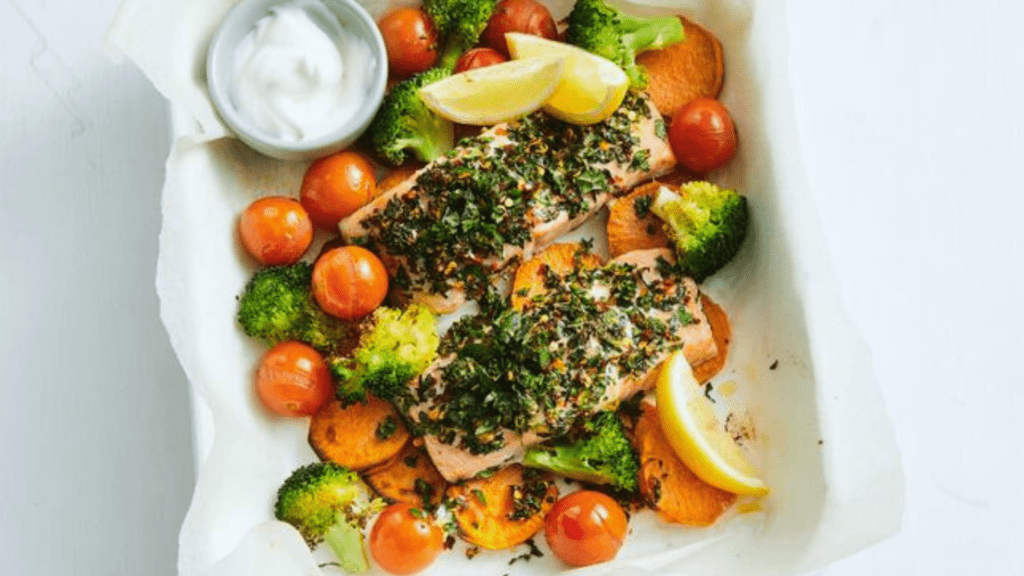
Ingredients:
- 2 salmon fillets
- 1 cup broccoli florets
- 1 cup cherry tomatoes
- 2 tablespoons olive oil
- Salt and pepper to taste
- 1 teaspoon garlic powder
Instructions:
- Preheat your oven to 400°F (200°C).
- Place the salmon fillets on a baking sheet and surround them with broccoli and cherry tomatoes.
- Drizzle with olive oil, and season with salt, pepper, and garlic powder.
- Bake for 15-20 minutes or until the salmon is cooked through and flakes easily with a fork.
This dish provides healthy omega-3 fatty acids and plenty of vitamins, making it a perfect choice for what to eat on rest day.
What to Eat on Rest Day: Meal Prep Tips
To make your meal planning even easier, here are some helpful meal prep tips:
- Batch Cooking: Prepare larger quantities of grains and proteins at the beginning of the week. For example, cook a big batch of quinoa or brown rice and grill several chicken breasts or bake tofu. This allows you to have ready-to-use ingredients for various meals throughout the week.
- Storage Solutions: To keep your meals fresh, invest in airtight containers. These are essential for storing prepped ingredients or complete meals. Labeling containers with dates can also help you keep track of freshness.
- Versatile Ingredients: Choose ingredients that can be used in multiple recipes. For instance, grilled chicken can be added to salads, wraps, or served with grains, making it a flexible option for what to eat on rest day.
- Prepare Snacks: Don’t forget about snacks! Chop up fruits and veggies in advance and portion them out for easy access. For example, having cut carrots, bell peppers, or apples ready to go can make it easier to maintain your nutrition goals.
By incorporating these easy recipes and meal prep tips into your routine, you can take the guesswork out of what to eat on rest day. Enjoy the convenience of having healthy meals at your fingertips, allowing you to focus on your recovery and prepare for your next workout. In the next section, we’ll delve into some additional resources and tips for maintaining a balanced diet on your fitness journey.
Smart Snacking: What to Eat on Rest Day to Support Recovery and Avoid Overeating
When planning what to eat on rest day, snacks can be a key part of recovery. They provide nutrients that support muscle repair, keep energy levels balanced, and prevent reaching for less nutritious options. Here’s a guide on nutritious snack ideas and portion control strategies to help you stay on track.
Healthy Snack Ideas for Rest Days
- Greek Yogurt with Honey
A simple snack that balances protein and carbohydrates. Greek yogurt provides high-quality protein for muscle recovery, while honey adds natural sugars to keep energy steady. - Mixed Nuts
Nuts contain healthy fats essential for hormone production, plus fiber for lasting fullness. Enjoy a small handful, as they’re calorie-dense but packed with nutrients. - Protein Bars
Opt for low-sugar protein bars with balanced protein and healthy fats. These make an ideal grab-and-go option and can satisfy hunger without the sugar rush. - Fruit with Nut Butter
Apple slices or orange segments offer fiber and vitamins, while a spoonful of almond or peanut butter adds protein and healthy fats to round out your snack.
What to Eat on Rest Day: Portion Control Strategies
Portion control can make all the difference on a rest day, helping prevent overconsumption. Here are some effective strategies:
- Use Smaller Bowls or Plates
Serving snacks in a smaller bowl makes portions look more substantial, helping you feel satisfied with a sensible amount. - Measure Out Servings
Pre-measuring portions—like a quarter cup of nuts or a single serving of yogurt—helps prevent mindless snacking. Knowing exactly how much you’re consuming keeps your intake balanced. - Eat Slowly and Mindfully
Savoring each bite can increase satisfaction and help you avoid reaching for extra helpings. Mindful eating can enhance enjoyment and prevent overeating. - Avoid Eating Directly from the Package
Many packaged snacks contain multiple servings, so taking out a portion in a separate dish prevents accidentally eating more than planned.
Choosing and managing snacks with care can support your body’s recovery and energy needs on rest days. Planning what to eat on rest day allows you to stay satisfied without overindulging. Next, we’ll cover hydration strategies to help you stay fully refreshed and ready for your next workout.
Special Considerations for What to Eat on Rest Day
When deciding what to eat on rest day, it’s important to take individual needs into account. Tailoring your nutrition to factors like age, weight, and dietary restrictions can make a big difference in reaching your fitness goals effectively and sustainably.
Individual Caloric Needs
Different bodies have different requirements, and on rest days, these variations can be particularly impactful. Here’s how to adjust based on individual factors:
- Age: Younger individuals, especially teens and young adults, may need more calories to support growth and development.
- Weight and Body Composition: Heavier or more muscular individuals typically have higher calorie needs, even on rest days, due to greater energy requirements for maintaining muscle.
- Activity Level: Those who are highly active on workout days may still require moderate calories on rest days to sustain energy levels and muscle recovery.
- Specific Fitness Goals:
- Muscle Gain: Keep protein intake consistent to support muscle repair.
- Weight Maintenance or Loss: Focus on balanced meals, keeping calorie intake slightly lower than on active days.
By aligning your intake with your specific caloric needs, you can make the most of your rest days without overdoing or undercutting your recovery.
Dietary Restrictions and Allergies
If you have dietary restrictions, knowing what to eat on rest day that fits your needs is key for optimal nutrition. Here are common dietary considerations and tips for adjustments:
- Dairy-Free: Use plant-based yogurts, cheeses, and milks (like almond, oat, or coconut) to get similar textures and flavors without the dairy.
- Nut-Free: Substitute seeds (such as sunflower or pumpkin) for nuts, and check labels on processed foods for hidden nuts.
- Vegan: Incorporate plant-based protein sources, like lentils, beans, and quinoa, to meet protein needs on rest days.
- Gluten-Free: Opt for gluten-free grains like rice, quinoa, and certified gluten-free oats to ensure you’re sticking to your needs without sacrificing nutrients.
Making thoughtful decisions about what to eat on rest day can enhance your recovery and keep you energized. By adjusting your choices based on your individual profile, you’re better equipped to support your health and fitness journey every day.
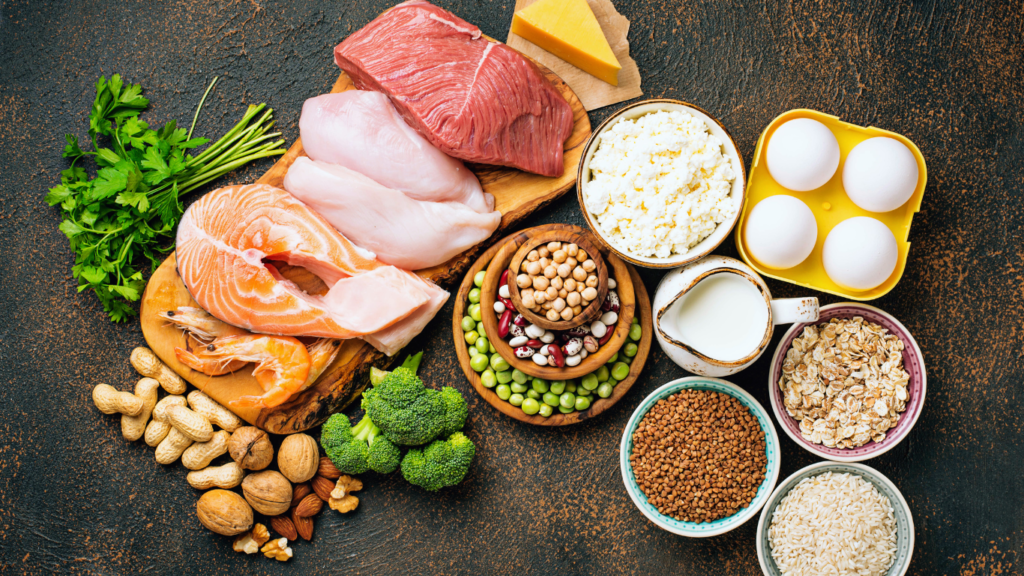
Final Thoughts on What to Eat on Rest Day
When it comes to what to eat on rest day, getting the right nutrition plays a crucial role in supporting recovery, maintaining energy, and furthering your fitness goals. Every part of your fitness journey, including rest days, has an impact on your progress, and understanding the value of balanced nutrition can make all the difference. Here’s a recap of the key points that were covered:
- Understanding Rest Days: Rest days, whether they involve complete rest or active recovery, are essential for muscle repair, preventing burnout, and reducing the risk of injury.
- The Role of Nutrition on Rest Days: While caloric needs may be slightly lower on rest days, it’s still important to consume a balanced intake of macronutrients. Carbohydrates help replenish glycogen stores, proteins aid in muscle repair, and healthy fats support hormone production.
- Nutritional Goals for Rest Days: Keeping energy levels steady, supporting muscle recovery, and staying hydrated are central goals on rest days. Simple strategies, like balanced meals and sufficient hydration, can enhance rest day benefits.
- Practical Food Choices: Choosing nutrient-dense foods within your budget is essential. Examples include whole grains, lean proteins, fruits, and vegetables, which are versatile and easy to incorporate into your daily meal plans.
- Easy-to-Make Recipes: Rest day nutrition doesn’t have to be complex. Simple recipes, like a protein-packed smoothie or chickpea salad, make it easy to nourish your body without spending too much time in the kitchen.
- Snacking on Rest Days: Healthy snacks can keep you full between meals and prevent overeating. Choose balanced snacks like Greek yogurt, mixed nuts, or fruit for sustained energy.
- Special Considerations: Individual needs, such as specific dietary restrictions or varying caloric requirements, should shape your approach to rest day nutrition. Adjusting your intake to fit your lifestyle is key to making rest days work for you.
Overall, viewing what to eat on rest day as an integral part of your fitness journey can help you recover effectively and prepare for your next workout. Treat your rest day nutrition as a tool to support the body’s needs, giving it the nutrients it needs to build strength, maintain energy, and prevent fatigue.
What to Eat on Rest Day: Frequently Asked Questions
1. Do I need as many calories on a rest day as on an active day?
Rest days often require slightly fewer calories, but it’s essential not to cut back too drastically. Your body still needs energy to repair muscles, maintain metabolism, and prepare for future workouts. Aim for balanced, nutrient-dense meals.
2. Should I change my protein intake on rest days?
No, protein remains important for muscle recovery on rest days. Keeping your intake consistent can support muscle repair and growth even when you’re not actively exercising.
3. What are the best snacks for rest days?
Choose snacks that are nutritious and filling, like Greek yogurt with honey, mixed nuts, or fruit with nut butter. These options help you stay satisfied without overloading on empty calories.
4. How can I stay hydrated on rest days?
Hydration is essential every day. Aim to drink water consistently throughout the day and include hydrating foods like cucumbers, oranges, and other water-rich fruits and vegetables.
5. Is it okay to have carbs on a rest day?
Absolutely! Carbohydrates are important for replenishing glycogen stores, which your muscles use as energy. Choose complex carbs like oats, quinoa, and sweet potatoes to support sustained energy.
6. Do I need to eat differently based on my fitness goals?
Yes, your nutrition should align with your goals. If you’re aiming to build muscle, keep protein intake high, even on rest days. For weight maintenance, focus on balanced, portion-controlled meals.
7. What if I have specific dietary restrictions?
Rest day nutrition can be adjusted to fit your dietary needs. For example, use dairy-free or gluten-free alternatives when necessary, and focus on whole, nutrient-dense foods that meet your requirements.
8. How can I avoid overeating on a rest day?
Try portion control strategies, like using smaller plates, measuring servings, or pre-planning meals and snacks. This can help you stay on track and avoid consuming extra calories.
9. Should I meal prep for rest days?
Yes, meal prepping can simplify rest day nutrition. Preparing grains, proteins, and veggies in advance makes it easy to create balanced meals without much effort.
10. Can I eat out or order takeout on a rest day?
Of course! Just be mindful of portion sizes and choose options with whole ingredients. Look for dishes with lean protein, vegetables, and whole grains to keep meals balanced.
Embrace your rest days with a focus on balanced nutrition, making every meal and snack count.

